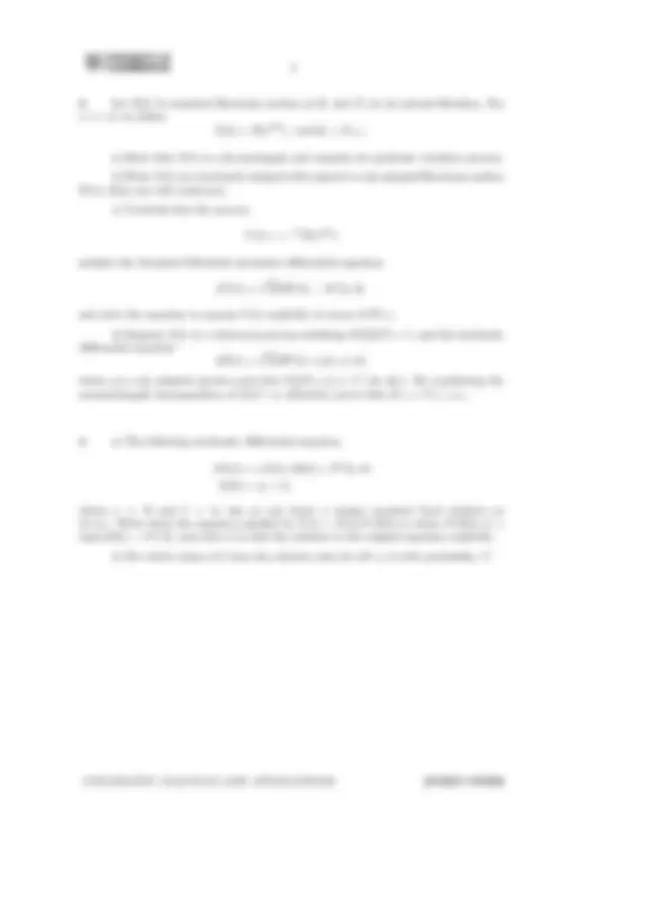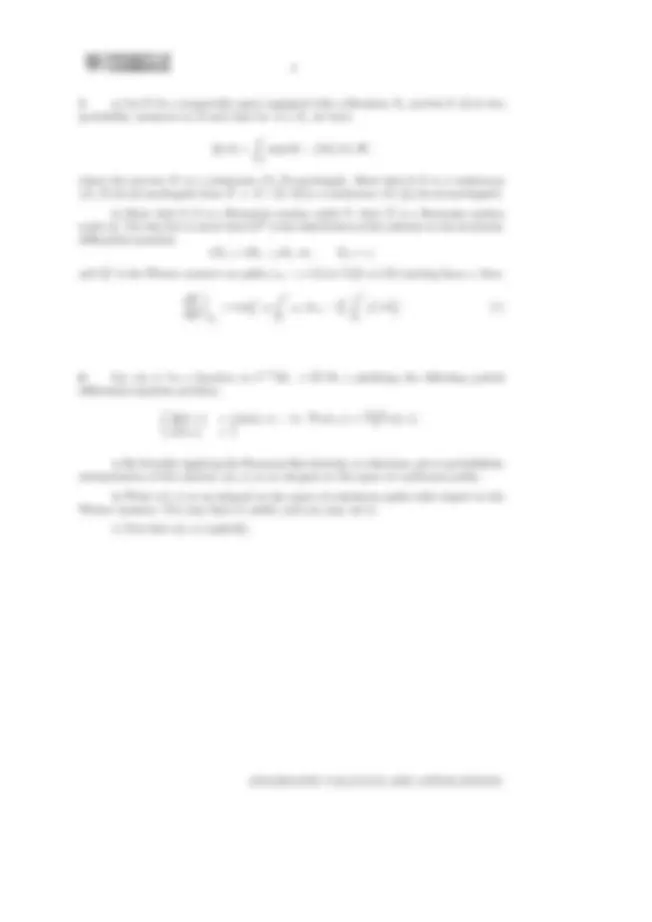




Study with the several resources on Docsity

Earn points by helping other students or get them with a premium plan


Prepare for your exams
Study with the several resources on Docsity

Earn points to download
Earn points by helping other students or get them with a premium plan
Community
Ask the community for help and clear up your study doubts
Discover the best universities in your country according to Docsity users
Free resources
Download our free guides on studying techniques, anxiety management strategies, and thesis advice from Docsity tutors
This is the Exam of Statistical Science which includes Stochastic Differential Equation, Brownian Motion, Solution, Measurable Function, Markov Process, Starting, Bounded Functions, Local Martingale, First Time etc. Key important points are: Stochastic Calculus and Applications, Measurable Space, Filtration, Previsible, Natural Filtration, Algebra, Bounded Martingale, Bounded, Measurable Random, Strictly Simple
Typology: Exams
1 / 4

This page cannot be seen from the preview
Don't miss anything!



Monday 31 May, 2004 1.30 to 4.
Attempt FOUR questions. There are six questions in total.
The questions carry equal weight.
1 Let X = (Ω, F) be a measurable space equipped with a probability measure P and a filtration {Ft}t≥ 0 , and let Xt(ω) be a continuous (Ft, P)-semimartingale.
a) Show that a continuous local martingale of finite variation starting from 0 must necessarily be identically 0, P-a.s.; therefore conclude that the decomposition of Xt into a local martingale part and a part of finite variation is unique.
b) Show that the quadratic variation process [X]t does not depend on the filtration. (You may use without proof any formula for [X]t proved in the lectures). Suppose now that Q is another probability measure, absolutely continuous with respect to P and that X is a (Q, Ft)-semimartingale, as well. Show that the quadratic variation process of X is the same regardless of which measure (P or Q) we use to compute it.
c) Prove that a local martingale Mt is a martingale if and only if for all t > 0 the family: {MT : T is a stopping time ≤ t}
is uniformly integrable.
2 a) State and prove the integration by parts formula for continuous semimartingales. State (the multidimensional) Itˆo’s formula, and describe (without proof) how to establish it from the integration by parts formula.
b) Let X(t) = B(t) + μt (μ 6 = 0), where B(t) is a Brownian motion on R started from x. For b > |x|, set T+ = inf{t ≥ 0 : X(t) ≥ b}, T− = inf{t ≥ 0 : X(t) ≤ −b} and T = T− ∧ T+. First show that E[T 2 ] < ∞. Then, using a suitable function f such that f (Xt) is a martingale, compute the probability P(T− < T+).
5 a) Let X be a measurable space equipped with a filtration Ft, and let P, Q be two probability measures on X such that for A ∈ Ft, we have:
A
exp(Mt − [M ]t/2) dP,
where the process M is a continuous (Ft, P)-martingale. Show that if X is a continuous (Ft, P)-(local martingale) then X˜ := X −[X, M ] is a continuous (Ft, Q)-(local martingale).
b) Show that if X is a Brownian motion under P, then X˜ is a Brownian motion under Q. Use this fact to show that if Px^ is the distribution of the solution to the stochastic differential equation: dXs = dBs − μXs ds, X 0 = x,
and Qx^ is the Wiener measure on paths (ωs : s > 0) in C([0, ∞); R) starting from x, then:
dPx dQx
Ft
= exp
−μ
∫ (^) t
0
ωs dωs − μ
2 2
∫ (^) t
0
ω^2 s ds
6 Let u(t, x) be a function in C^1 ,^2 (R+ × Rd; R+) satisfying the following partial differential equation problem:
{ ∂u ∂t (t, x)^ =^
1 2 ∆u(t, x)^ −^ λx^ · ∇u(t, x) +^
λ^2 |x|^2 2 u(t, x) u(0, x) = 1.
a) By formally applying the Feynman-Kac formula, or otherwise, give a probabilistic interpretation of the solution u(t, x) as an integral on the space of continuous paths.
b) Write u(t, x) as an integral on the space of continuous paths with respect to the Wiener measure. You may find (1) useful, and you may use it.
c) Now find u(t, x) explicitly.